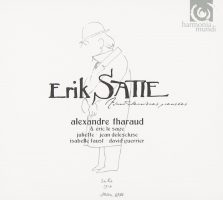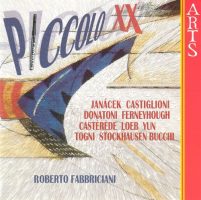Used Bin Troll Tweets Y.
|
Ethelbert Nevin [April 2017.]
Erik SATIE: Socrate (1919; arr. John CAGE, 1944). Ferenc LISZT: Via Crucis (1876-78). Dezső Ránki, Edit Klukon (pno). Budapest Music Center Records BMC CD 100 (1 CD) (http://www.bmcrecords.hu/). This duo piano release crafts a universe where Liszt, Satie and Cage blur. Is Via Crucis colorless and ephemeral? Is Socrate religious? YES.
“Erik Satie: Avant-dernières Pensées.” Erik SATIE: Var. comps. Alexandre Tharaud, Éric Le Sage (pno), Juliette (voice), Jean Delescluse (ten), Isabelle Faust (vln), David Guerrier (tpt). Harmonia Mundi HMC 902017.18 (2 CDs) (http://www.harmoniamundi.com/). A first disc of solos, a second of duos. Solid concept, all good players, but way too much rubato. Satie was hardly a reluctant Romantic. NO.
Ned ROREM: Pilgrims (1958); Flute Concerto (2002); Violin Concerto (1985). Jeffrey Khaner (fl), Philippe Quint (vln), Royal Liverpool Philharmonic Orchestra, José Serebrier (cond.). Naxos 8.559278 (1 CD) (http://www.naxos.com/). Rorem aficionados must already have this. The rest of us should be able to get past the lyric sheen and admire the orchestral palette. MAYBE.
“Piccolo XX.” Leos JANÁČEK: Pochod Modrácku (1924)*. Niccolò CASTIGLIONI: Musica Vneukokvahja (1965-81). Franco DONATONI: Nidi (1979). Brian FERNEYHOUGH: Superscriptio (1981). Jacques CASTÉRÈDE: La Belle Epoque (1984)*. David LOEB: Six Preludes (1982). Isang YUN: Allegro (1974). Camillo TOGNI: Tre Preludi (1978-81). Karlheinz STOCKHAUSEN: Tierkreis, Op. 41 (1975). Valentino BUCCHI: Piccolo Concerto (1973)**. Roberto Fabbriciani (picc), Massimiliano Damerini* (pno), Orchestra da Camera “I Solisti di Fiesole,”** Nicola Paszkowski** (cond.). ARTS 47557-2 (1 CD) (http://www.artsmusic.de/). Part of a hard-to-find series, Fabbriciani’s piccolo entertains from goofy Castérède to doctrinaire Stockhausen and astonishing Bucchi. YES.
“The Links Series of Vibraphone Essays.” Stuart Saunders SMITH: Links (1974)1; Links No. 2 (1975)2; Links No. 3 (1975)3; Links No. 4, “Monk” (1982)4; Links No. 5, “Sitting on the Edge of Nothing” (1987)5; Links No. 6, “Song Interiors” (1989)6; Links No. 7, “New England Night Weave” (1989)7; Links No. 8, “Confessions—Witness to 48 Things” (1990)8; Links No. 9, “Mosque” (1992)9; Links No. 10, “Who are we? Where are we?” (1993)10; Links No. 11, “Regions I-XXI” (1994)11. Masako Kunimoto1, Steven Sehman2, Bill Sallak3, Steven Schick4, Aiyun Huang5, Fabio Oliviera5, Justin DeHart6,9, Jude Traxler7, Berndt Thurner8, Ayano Kataoka10, Chris Leonard11, Dale Speicher11, Matthew Apanius11 (vibr), Katalin Lukács6 (pno), Gisela Mashayekhi-Beer8 (fl). New World Records 80690-2 (2 CDs) (http://www.newworldrecords.org/). Smith’s “autobiographical” style spans decades, embracing various influences for an interlocked collection of mostly vibraphone solos. MAYBE.
Ludwig van BEETHOVEN: Sonata No. 4 in E flat, Op. 7 (1796); Sonata No. 15 in D, Op. 28, “Pastoral” (1801); Sonata No. 20 in G, Op. 49, No. 2 (1795-96). Alfred Brendel (pno). Philips 446 624-2 (1 CD) (http://www.deccaclassics.com/). Perhaps Brendel was caught on an off day back in June 1994, or perhaps these three sonatas flesh out the better parts of a complete set. NO.
Beethoven, Bucchi, Cage, Casterede, Castiglioni, Donatoni, Ferneyhough, Janáček, Liszt, Loeb, Rorem, Satie, SS Smith, Stockhausen, Togni, Yun
[More Ethelbert Nevin, Used Bin Troll Tweets]
[More
Beethoven, Bucchi, Cage, Casterede, Castiglioni, Donatoni, Ferneyhough, Janáček, Liszt, Loeb, Rorem, Satie, SS Smith, Stockhausen, Togni, Yun]
[Previous Article:
New and Near New in Boston]
[Next Article:
Piano Factory 19.]
|





